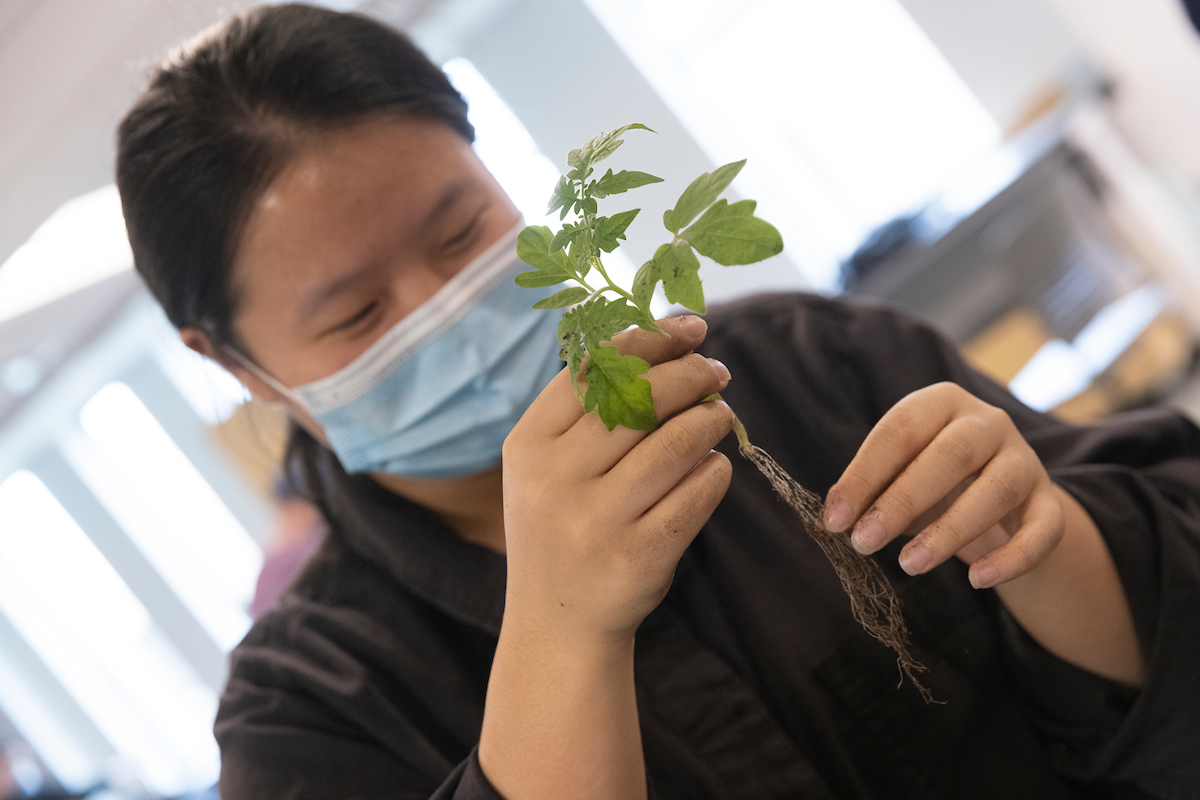Planting the seeds: Biology lab course introduces students to research

An abandoned paper mask blows off the walkway into a ditch, where spring rains carry it into a local wetland. Through wind, water and weather, it slowly dissolves.
How does this breakdown affect the environment? Students in BIOL 115: Introductory Biology are conducting research to find out.
Since 2018, the course has followed a Course-based Undergraduate Research Experience (CURE) model similar to the First-Year Research Immersion program. Unlike FRI, however, students conduct their research project over a single semester and the class, a requirement for biological sciences majors, is open to anyone; more than 850 students take it every year.
“That means that all of our biology majors have an opportunity to do real science!” said biological sciences lecturer Miranda Kearney. “Our class research questions explore human disturbances to the environment and are tied to global change biology.”
Kearney provides the research question, an unknown that students will attempt to answer during the course of the semester. One such question — on the deer population’s impact on microbial communities in the Binghamton University Nature Preserve — has led to a published journal article.
The coronavirus pandemic and its omnipresent masks proved a source of research inspiration. The fiber in disposable face masks consists of multiple layers of fused plastic materials, which can shed particles of microplastics as they decay, Kearney explained. Decorated masks also could potentially leach heavy metals, dyes or other materials into the environment as well.
For their experiment, students created their own mask leachate by soaking masks in water for around 3 hours, agitating them for maximum breakdown. Some of the masks were new, and others were worn for 24 hours to create two research groups. Masks were also sorted into the plain paper sort and fancier, decorated masks.
“By comparing the growth rate, size and other health indicators of the plants we should be able to come to a conclusion about how littered masks are affecting the environment,” explained sophomore environmental sciences major Benjamin Prigg, who hopes to one day do fieldwork with an organization such as the National Park Service or the U.S. Fish and Wildlife Service.
The researchers then applied the leachate from the mask groups to tomato seeds and monitored their growth over a five-week period to determine its impact on plant growth and development; the control group used distilled water instead. So students could get a good look at the plants’ root structure, they were sown in narrow devices that strongly resemble CD jewel cases. After analyzing their results, the class will present its findings in research posters.
First-year psychology major Samantha Ward has no prior research experience, which is exactly why she chose the class. She found herself fascinated by the first roots that emerged from the seedling and the growth that followed.
“Even if you grew up in the countryside or gardened in your lifetime, you have never really seen the roots from your plants,” reflected Ward, whose long-term goal is to become a physician. “To see them in the clear CD cases where you could see how they have grown and moved throughout the dirt was very interesting.”
There have been a few minor surprises, said Eesha Alladin, a first-year biological sciences student who hopes to one day pursue research in the medical field.
“What surprised me was that even when the tomato plants absorbed leachate solution from used masks, some of the tomato plants still grew a lot,” Alladin said. “I assumed that the microparticles given off from the (disposable face masks) would stunt the plant growth. However, the tomato plants still grew fairly large in comparison to the tomato plants given distilled water.”
Students said they particularly appreciated the hands-on nature of the class, but there were other highlights, too, from learning new software to creating poster and oral presentations. They also learned how to read and write scientific articles, which is useful for many majors, said first-year integrative neuroscience major Amanda Dwyer. Prigg said he appreciated the teamwork he found with his classmates, who were very dedicated to the task.
“This course has made me realize I enjoy lab work much more than I previously thought. I struggled more with lab work in high school, but I have managed well in this course and am fully invested in what we’re experimenting with,” said first-year student Julia Flynn, who is considering a biological sciences major. “It’s been a good learning experience and helped me get my feet wet in terms of college-level lab work.”

